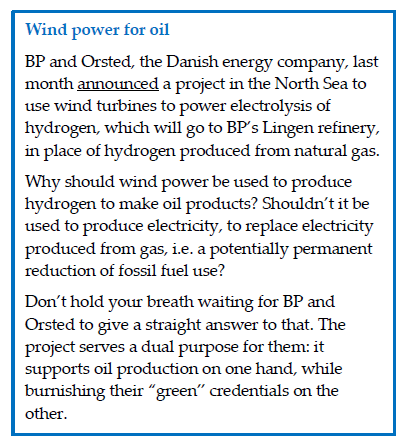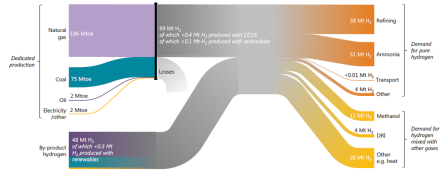https://peopleandnature.wordpress.com/2020/12/18/the-hydrogen-hoax/
The hydrogen hoax
“Low carbon?” Its emissions are more than twice the UK economy’s
All of a sudden, hydrogen is (supposedly) a weapon to fight global warming. Governments are bigging it up in their “net zero” plans; oil companies say they are investing in it; union leaders say it will create jobs.
But no-one talks about the really existing hydrogen industry, that each year produces about 70 million tonnes of pure hydrogen, and another 45 million tonnes of hydrogen in other chemical products … and pours 830 million tonnes of carbon dioxide into the atmosphere.
Yes, you read that right. 830 million tonnes of CO2 per year. 2% of total global total greenhouse gas emissions. Equal to about four-fifths of the emissions from aviation; more than twice the entire UK economy’s emissions. (See Endnote 1 about the numbers.)
Of that 115 million tonnes of hydrogen output, more than 99% is “grey” hydrogen – which means it is extracted from natural gas, coal or oil, and the carbon dioxide left over ends up in the air.
It’s fashionable to talk about “blue” hydrogen (made from fossil fuels, but with the carbon captured and stored, instead of being emitted) and “green” hydrogen  (produced by electrolysis of water, using gigantic quantities of electricity). But these techniques are used only in a tiny handful of businesses. “Grey” hydrogen is completely dominant.
(produced by electrolysis of water, using gigantic quantities of electricity). But these techniques are used only in a tiny handful of businesses. “Grey” hydrogen is completely dominant.
Companies and governments are promising to expand “blue” and “green” hydrogen production. They claim it will replace natural gas to heat people’s homes, and petrol for cars, and that it will cut carbon emissions.
But before expanding hydrogen production, what about decarbonising existing output?
That would be a big cut in the world’s carbon emissions. Nearly as big a cut as if aviation stopped. More than twice as big a cut as if the UK went to zero.
It would also mean a big shake-up of some of the world’s most polluting industries – oil refining and petrochemicals production – where the hydrogen is produced and used.
There is little mention of hydrogen’s gigantic carbon footprint in the glossy reports, press releases and “net zero” policies of the companies that produce it. But a report published last year by the International Energy Agency mapped hydrogen use as follows:
■ One third (33%) of the global total of hydrogen use (38 million tonnes/year) is in oil refineries. Most of this is produced on site, mostly from natural gas; those volumes are supplemented by hydrogen bought in from merchant suppliers. Hydrogen is used in chemical processes that remove sulphur and other impurities from crude oil. Hydrogen used in refineries produces about 230 million tonnes/year of CO2 emissions (that is a bit more than the entire economy of Singapore, a bit less than France).
■ Another 27% of the hydrogen, including a good chunk of hydrogen embedded in another chemicals, goes into the production of ammonia. That in turn is used mainly to make chemical fertilisers (e.g. urea and ammonium nitrate); a smaller amount goes into explosives, synthetic fibres and other chemical products.
■ The next biggest use of hydrogen, 11% of the total, is to produce methanol, a type of alcohol used to make solvents, fuel products and antifreeze.
■ About 3% of the world’s hydrogen is used in the direct reduction of iron (DRI) process to make steel.
■ Hydrogen is used in other chemicals processes, and to supply high-temperature heat to industry.
The IEA report aggregates useful information about hydrogen production, and its mammoth carbon footprint, that is hard to glean from statistics. The fuels used, and the associated emissions, are spread across statistical categories covering refineries, petrochemicals, steelmaking and so on, obscuring the scale of the problem. (See Endnote 2.)
In the face of the big push by governments and companies to claim hydrogen as a “low carbon fuel”, better quality information is needed.
Boris Johnson, the UK prime minister, put hydrogen at the centre of his ten-point “net zero” PR stunt last month. He said the government would invest up to £500 million in new production facilities and trialling hydrogen use to heat homes. He talked about building a “hydrogen town” and about generating 5GW of low-carbon hydrogen by 2030.
But before a penny is handed to companies producing hydrogen, is no-one going to ask them for a proper inventory of current output? Is anyone going to check what they are doing about their share of the 830 mt/year of CO2 emissions?
Where is the evidence that this hydrogen spending spree would be more effective than demand-side solutions – such as insulating homes so that they don’t need much heat, and providing the heat that’s needed with electric pumps, as trade unionists in Leeds propose?
Unless such questions are asked, we can take the hydrogen hype as a reminder that governments’ “decarbonisation” strategies are aimed chiefly at concealing the lack of progress towards decarbonisation.
Unless such questions are asked, we can be sure that hydrogen is being used not to cut carbon emissions at the speed required, but to support the powerful companies that use it, and make them look “greener” than they are.
Those companies are, in the first place, oil and gas companies, from whose products most hydrogen is produced, and who use one-third of it in refineries.
Will “blue” hydrogen ever be any use in the transition away from fossil fuels? I don’t know; I am not a chemical engineer. But I know that the inflated claims for its role in
tackling climate change rest on the assumption that carbon capture and storage (CCS) – which, despite repeated efforts over the last 30-40 years by oil companies and others, has never been made to work at scale – can work at scale.
And I know that any political approach that proceeds from what is good for society as a whole, rather than from what is good for the companies or “the economy”, would pose, at a minimum, these questions:
■ Where is the clearly separated-out accounting (resource accounting, not money accounting) of the fossil fuels used to produce hydrogen, the CO2 emissions from the process, and emissions from products in which the hydrogen is embodied (such as fertilisers)?
■ What are the life cycle assessments of the processes that involve hydrogen production and use, including their carbon footprints?
■ What is being done, or not done, to retrofit current hydrogen production with carbon capture and storage? If it is not being done, why not? What are the engineers’ comparisons between retrofitting and newly-built hydrogen facilities with CCS?
■ What do the engineers say about the potential for substituting hydrogen in industrial processes with zero-carbon alternatives?
■ Since hydrogen is so thoroughly embedded in the oil industry, how will it be affected by the decline in oil production that the companies promise? Will hydrogen now used for oil production be available for other uses?
The answers to these questions probably hold the key as to whether “blue” hydrogen can ever play a meaningful part in a serious decarbonisation strategy. I think that is doubtful.
“Green” hydrogen has its own problems. Yes, it is technically possible to use renewably-produced electricity to electrolyse water, to make hydrogen – but you need a huge amount of electricity to produce a small amount of hydrogen.
Maybe my grandchildren will live in a world where this becomes a common way of doing things. But right now we live in a world where (1) just short of two-thirds of  electricity is still produced from fossil fuels, and (2) many decarbonisation plans – for the transport sector, for example, or home heating – rely on the assumption that still more electricity will soon be available.
electricity is still produced from fossil fuels, and (2) many decarbonisation plans – for the transport sector, for example, or home heating – rely on the assumption that still more electricity will soon be available.
So, for a long time into the future – even assuming that all the most optimistic plans for decarbonising electricity are implemented – there is going to be much, much less renewably-produced electricity available than is needed.
Will using part of that limited supply of renewably-produced electricity to make hydrogen, which is such an energy-inefficient process, ever make sense?
To make 70 million tonnes of pure hydrogen per year (current global output), you would need about one-and-a-half times as much renewable electricity as the world produces.
These technological dilemmas could best be resolved by governments, companies, communities, or whoever controls the economic entities, working out integrated plans based on using energy resources efficiently, in ways that society needs. Principles long understood by researchers of industry and ecology – in the first place, that reducing energy throughput is always a more effective means of decarbonisation than substituting one technology for another while leaving the economic framework untouched – could then be put into practice.
But such integrated approaches, based on society’s needs, are the opposite of the contorted solutions devised in the international climate talks – that is, a combination of failed market mechanisms and uncertain techno-fixes.
Those contorted solutions produce illusions of “decarbonisation” that dovetail with oil companies’ needs. Effective approaches to tackling dangerous climate change mean confronting and defeating those oil companies and the social forces that support them.
Don’t be deluded by hydrogen hype. Deal with the emissions from current hydrogen production before talking about future “low carbon” hydrogen. Stop state funding for hydrogen projects that do not serve the public interest. GL, 18 December 2020.
■ Hydrogen for homes is a terrible idea. We should fight it (People & Nature, October 2020)
Endnote 1. CO2 emissions from hydrogen production are 830 million tonnes per year (mt/year), the IEA’s Future of Hydrogen report says. That’s more than four-fifths of 1034 mt, global aviation emissions in 2018, as stated here and explained here. I compared the total emissions from hydrogen production with the UK’s (387 mt), and the emissions from hydrogen production in oil refineries (230 mt, the IEA says) with Singapore’s (219 mt) and France’s (299 mt) – all 2019 figures from the BP statistical review. On the amount of renewable electricity needed to produce hydrogen, the IEA report says (p. 37) that to get 70 mt of hydrogen would require 3600 terawatt hours (TWh) of electricity; in 2018, the world’s renewable electricity output was 2468 TWh, the BP statistical review says.
Endnote 2. The IEA’s report last year brought together information on hydrogen that has previously been dispersed. In the Intergovernmental Panel on Climate Change (IPCC) reports (e.g. here), the emissions from hydrogen production appear to be spread between categories for oil refining, petrochemicals, fuels used as feedstock, and other industries. This seems to happen, too, with the national data (such as the UK’s, here, for example). The volumes of gas and coal used to produce hydrogen are divided between a number of categories in the IEA’s own published statistics.
The best national-level information on hydrogen production seems to come from the US, where the Department of Energy last year came up with similar numbers to the IEA’s: global pure hydrogen output of 61-70 mt/year, plus 41 mt/year in other chemical products, by the widest measure used. Those analysts reckon that 9-15 mt/year of the world’s hydrogen is produced in the US. Beyond that, the geographical breakdown is not obvious. The IEA report does not list hydrogen production volumes by country.
There are limits, too, to the information released by companies that produce hydrogen. Researchers at Cambridge university who study material flows through industry complained in a recent paper about the “dearth of public data” on the chemical sector, compared to the steel and aluminium industries they had looked at previously.


No comments:
Post a Comment